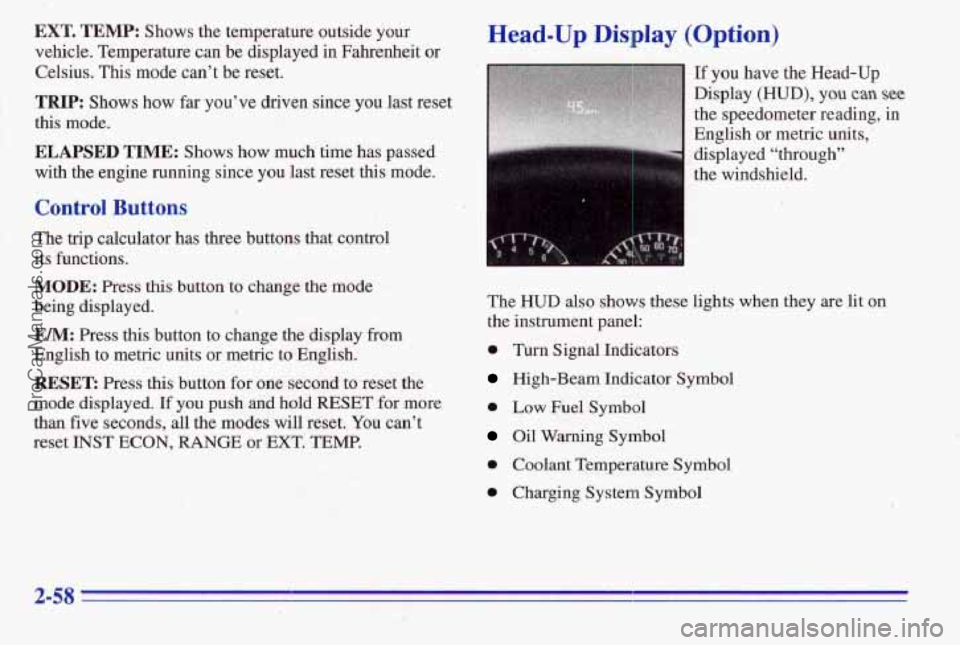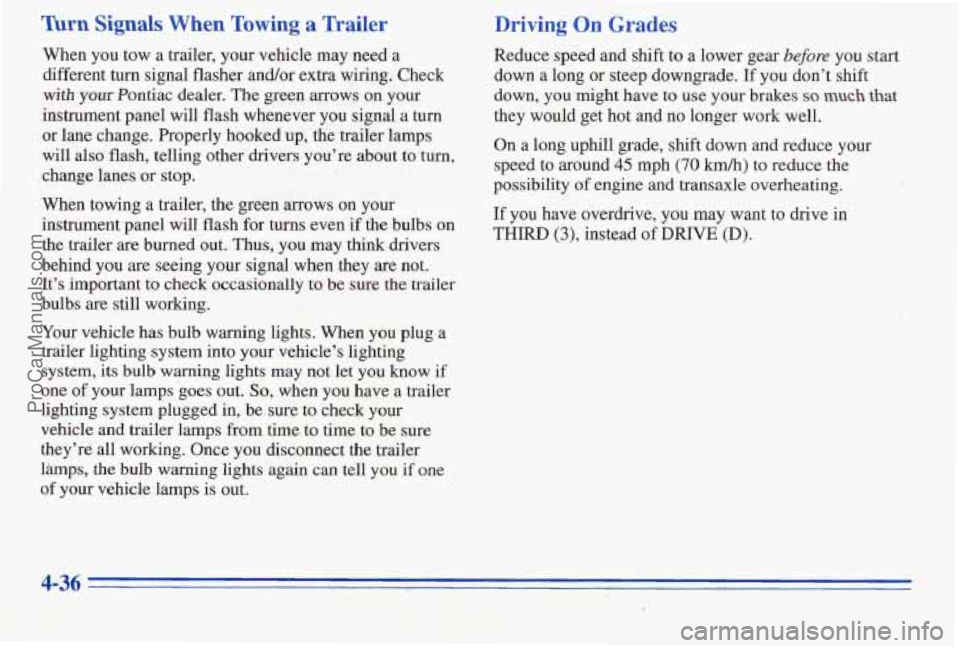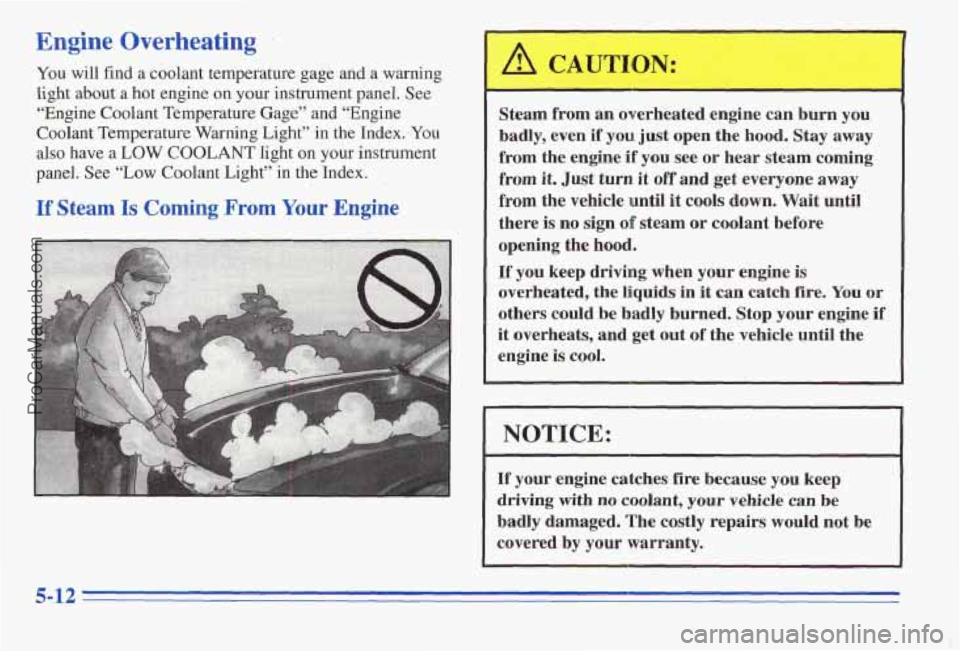Page 127 of 370

EXT. TEMP: Shows the temperature outside your
vehicle. Temperature can be displayed in Fahrenheit or
Celsius. This mode can’t be reset.
TRIP: Shows how far you’ve driv’en since you last reset
this mode.
ELAPSED TIME: Shows how much time has passed
with the engine running since you last reset this mode.
Control Buttons
The trip calculator has three buttons that control
its functions.
MODE: Press this button to change the mode
being displayed.
EM: Press this button to change the display from
English to metric units or metric to English.
RESET: Press this button for one second to reset the
mode displayed.
If you push and hold RESET for more
than five seconds, all the modes will reset. You can’t
reset
INST ECON, RANGE or EXT. TEMP.
Head-Up Display (Option)
If you have the Head-Up
Display
(HUD), you can see
the speedometer reading, in
English or metric units,
’
displayed “through”
the windshield.
The
HUD also shows these lights when they are lit on
the instrument panel:
0 Turn Signal Indicators
High-Beam Indicator Symbol
0 Low Fuel Symbol
Oil Warning Symbol
0 Coolant Temperature Symbol
0 Charging System Symbol
ProCarManuals.com
Page 130 of 370
If You Can’t See the HUD Image When the Ignition
Is On
If the HUD Image Is Not Clear
Is the HUD image too bright?
0
0
0
0
Is anything covering the HUD unit?
Is the HUD dimmer setting bright enough?
Is the HUD image adjusted to the proper height? have to have a new windshield, be sure to get one
0 Are the windshield and HUD lens clean?
Your windshield is
part of the HUD system. If you ever
Still no
HUD image? Check the fuse in the
I/P Electronics position in the instrument panel
fuse block. See “Fuses and Circuit Breakers” in
the Index,. designed for
HUD. If you. don’t, the HUD image may
look blurred and out
of focus.
2-61 ..
ProCarManuals.com
Page 133 of 370

Mode Knob
The right knob has several settings to control the
direction of airflow. For each setting, set the temperature
to
a comfortable setting.
MAX: This setting recirculates much of the air inside
your vehicle
and sends it through the instrument panel
automatically
in this setting unless the outside
temperature is below
40°F (4.5"C). (Even when the
compressor
is running, you can control the temperature.)
+e
/J VENT This setting brings in outside air and
directs it through the instrument panel outlets.
+# BI-LEVEL: This setting brings in outside air and
directs
it two ways. Half of the air is directed through
the instrument panel outlets. Most
of the remaining air is
directed through the floor ducts and a little to the defrost
and side window vents.
?# FLOOR: This setting sends most of the air
through the ducts near the floor. The rest comes out of
the defroster. and side window vents.
sl3,
+# DEFOG: This setting allows half of the air to
go to the floor ducts and half to the defroster and side
window vents.
, outlets. The air conditioning compressor will run
+a
DEFROST: This setting directs most of the air
through the defroster and side window vents. Some of
the
air goes to the floor ducts, The air conditioning
compressor will run automatically in this setting unless
the outside temperature is below
40°F (4.5"C).
(Even when the compressor is running, you can control
the temperature.)
Air Conditioning Compressor Button
Press the A/C button to operate the air conditioning
compressor. The indicator light above the button will glow
when the button
is pressed. You don't have to press the
button to run the compressor in MAX or DEFROST.
Air Conditioning
On very hot-days, open the windows long enough to let
hot, inside air escape. This reduces the time
the
compressor has to run, which should help fuel economy.
For quick cool-down on very hot days, use MAX with
the temperature
knob all the way in the blue area. If this
setting is used for long periods of time, the
air in your
vehicle may become too
dry.
ror normal cooling on hot days, turn the control knob to
the
VENT position, with the temperature knob in the
blue area and press the A/C button once (the indicator
ProCarManuals.com
Page 162 of 370
And this warning light on
the instrument panel will
come on briefly when you
start your vehicle.
When you start your engine, or when you begin to drive
away, your anti-lock brake system will check itself. ‘You
may hear a momentary motor or clicking noise while
this test
is going on, and you may even notice that your
brake pedal moves a little. This is normal.
If there’s a problem with the anti-lock brake system, the
anti-lock brake system warning light will stay on or
flash. See “Anti-Lock Brake System Warning Light” in
the Index. Here’s how anti-lock works. Let’s say
the road is wet.
You’re driving safely. Suddenly an animal jumps out in
front of you.
You slam on the brakes. Here’s what happens with
ABS.
A computer senses that wheels are slowing down. If one
of the wheels is about to stop rolling, the computer will
separately work the brakes at each front wheel and at the
rear wheels.
4-7
ProCarManuals.com
Page 191 of 370

Turn Signals When Towing a Wailer
When you tow a trailer, your vehicle may need a
different turn signal flasher and/or extra wiring. Check
with your Pontiac dealer. The green arrows on your
instrument panel will
flash whenever you signal a turn
or lane change. Properly hooked up, the trailer lamps
will also flash, telling other drivers you’re about to
turn,
change lanes or stop.
When towing a trailer, the green arrows on your
instrument panel will, flash for turns even if the bulbs
on
the trailer are burned out. Thus, you may think drivers
behind you are seeing your signal when they are not.
It’s important to check occasionally
to be sure the trailer
bulbs are still working.
Your vehicle has bulb warning lights. When you plug a
trailer lighting system into your vehicle’s lighting
system, its bulb warning lights may not let you
know if
one
of your lamps goes out. So, when you have a trailer
lighting system plugged
in, be sure to check your
vehicle and trailer lamps from time to time to be
sure
they’re all working. Once you disconnect the trailer
lhmps,
the bulb warning lights again can tell you if one
of your vehicle lamps is out.
Driving On Grades
Reduce speed and shift to a lower gear before you start
down a long or steep downgrade. If you don’t shift
down, you might have to use your
brakes so much that
they wouJd get hot and no longer work well.
On a long uphill grade, shift down and reduce your
speed to around
45 mph (70 km/h) to reduce the
possibility
of engine and transaxle overheating.
If you have overdrive, you may want to drive in
THIRD (3), instead of DRIVE (D).
4-36
ProCarManuals.com
Page 205 of 370

Engine Overheating
You will find a coolant temperature gage and a warning
light about a hot engine on your instrument panel. See
“Engine Coolant Temperature Gage” and “Engine
Coolant Temperature Warning Light” in the Index. You
also have
a LOW COOLANT light on your instrument
panel. See
“Low Coolant Light” in the Index.
If Steam Is Coming From Your Engine
Steam from an overheated engine can burn you
badly, even if you just open the hood. Stay away
from the engine
if you see or hear steam coming
from it. Just turn it off and get everyone away
from the vehicle until
it cools clown. Wait until
there
is no sign of steam or coolant before
opening the
hood.
If you keep driving when your engine is
overheated, the liquids in it can catch fire, You or
others could be badly burned. Stop your engine if
it overheats, and get out of the vehicle until the
engine
is cool.
I I
NOTICE:
If your engine catches fire because you keep
driving with no coolant, your vehicle can be
badly damaged. The costly repairs would not be
covered by
your warranty.
5-12
ProCarManuals.com
Page 230 of 370

If your vehicle is certified to meet California Emission
Standards (indicated on the underhood tune-up label),
it is designed to operate on fuels that meet California
specifications. If such fuels are not available in states
adopting California emissions standards, your vehicle
will operate satisfactorily on fuels meeting federal
specifications, but emission control system performapce
may be affected. The malfunction indicator lamp on
your instrument panel may
turn on and/or your vehicle
may fail a smog-check test. If this occurs, return to your
authorized Pontiac dealer for diagnosis to determine the
cause of failure. In the event it is determined that the
cause of the condition
is the type of fuels used, repairs
may not be covered by your warranty.
In Canada, some gasolines contain an octane enhancing
additive called MMT. If you use such fuels, your
emission control system performance may deteriorate
and the malfunction indicator lamp on your instrument
panel may turn on. If this happens, return to your
authorized Pontiac dealer for service. and ethanol, and reformulated gasolines
may
be
available in your area to help clean the air. General
Motors recommends that you use these gasolines if they
comply with the specifications described earlier.
NOTICE:
Your vehicle was not designed for fuel that
contains methanol. Don’t use it. It can corrode
metal parts in your fuel system and also damage
plastic and rubber parts. That damage wouldn’t
be covered under your warranty.
To provide cleaner air, all gasolines are now required to
contain additives that will help prevent deposits from
forming in your engine
and fuel system, allowing your
emission control system to function properly. Therefore,
you should not have to add anything to the fuel. In
addition, gasolines containing oxygenates, such as ethers
6-3
ProCarManuals.com
Page 237 of 370
Before closing the hood, be sure all the filler caps are
on properly. Then just pull the hood down and close
it firmly.
Engine Oil
I
LOW OIL
LEVEL
If the LOW OIL LEVEL
light on the instrument
panel comes on, it means
you need to check your
engine oil level right away.
3.1L L82 Engine 3.4L LQl Engine
For .more information, see
“Low Oil Level Light” in‘ the
Index. You should check
your engine oil level regularly;
this is
an added reminder.
It’s
a good idea to check your engine oil after you get
fuel.
In order to get an accurate reading, the oil must be
hot
and the vehicle must be on level ground, I-
The engine oil dipstick handle is the yellow loop near
the front of the engine.
Turn off the engine and give the oil 20 minutes to drain
back into the oil pan. If you don’t, the oil dipstick might
not
show the actual level.
6-10
ProCarManuals.com